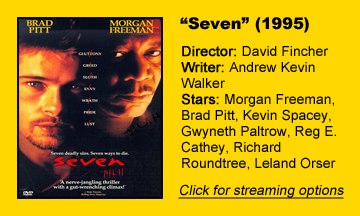As brutal as “Seven’s” (1995) subject is, you’d think it’d have no chance of ranking in IMDb’s all-time top 20. But that goes to show how expertly crafted this serial-killer pursuit yarn is in every way. Director David Fincher, whose only previous film was the studio-mangled “Alien 3,” paints New York City as such a cesspool that there’s no way anyone would want to set foot there after seeing “Seven.” It’s the exact opposite of a tourism video.
Masterfully designed
And he achieves it by shooting in Los Angeles. (NYC is never mentioned in the film, but writer Andrew Kevin Walker had the Big Apple in mind. If we’re not supposed to think of NYC when watching this film, well then that’s the only thing Fincher screwed up.)
The drenching rain, the grotesque apartment units and the filth-strewn alleys all paint a picture that lines up with villain John Doe’s (Kevin Spacey) assertion that humankind is beyond salvation. (Admittedly, the library looks nice, though.)
Morgan Freeman (as outgoing detective Somerset) and Brad Pitt (as young detective Mills) are at the top of their powers, but Gwyneth Paltrow’s smaller role as Mills’ wife Tracy is the most important for illustrating “Seven’s” theme and vibe.
A fresh-faced schoolteacher who is between jobs, Tracy looks like she’s ready to take on the world, but she admits to Somerset (she’s not willing to put this on her husband), that the public schools are so horrid that she can’t bring herself to work there. Her decision on whether to have or abort her baby is based on how awful the city is.
By being such an innocent, Tracy makes for an ideal final potential victim in Doe’s grand game where he commits crimes where the victims illustrate the Seven Deadly Sins.
Cliches feel fresh again
Fincher and the two leads make clichés fresh again. Mills is the hotshot, but all of his attempts to sound street-smart and cool fall flat. Pitt says the lines with a certain amount of conviction, but when Somerset doesn’t react at all to Mills’ antics, he might as well sound like you or me trying to be cool. Freeman’s world-weariness actually makes Brad Pitt come off as uncool.
And yet Freeman also dodges the cliché of an a**h***. Sure, he’s short with people – note the small scene where he tells the guy scraping his name off his office window to stop it – but it’s clear that his environment has made him this way. He’s too old for this s***, but in “Seven” we feel the truth of that statement rather than giggling at the trope.
The dinner sequence is also a cliché, but here it’s filled with so much subtle heart as Tracy’s appreciation for both men – her husband and his grizzled partner whom she immediately tabs as a good person – solidifies the partnership and allows “Seven” to focus on the next phase of the case.
But it’s interesting to note that “Seven” is a mystery in structure only; the detectives are just picking up the pieces after each of Doe’s crimes – as Somerset spells out as the duo waits overnight on a couch for fingerprint results.

Mostly off-screen until the final act, Doe controls this narrative every step of the way, starting with the first shocking murder scene where he had forced an obese man to eat until he bursts.
Oddly easy to watch
Obviously, “Seven” is not a movie you’d recommend to anyone – you’d have to first determine that they can handle darker stuff – but it actually doesn’t show that many gruesome images. And that probably explains why such a dark movie can creep into a top 20 that you’d guess would be the domain of wide-appeal films.
It’s actually super-easy to watch for a few reasons: It’s so evocative of its location, the leads overcome their clichéd roots to become real people, and the Seven Deadly Sins theme raises the fascinating question of whether the disgusting aspects of humans means we should give up on the race. John Doe is morally wrong in his actions, but he’s intellectually above reproach.
Instead of horror-film-level images, Fincher relies on impeccable performances to strongly imply what happened, ranging from a man (Leland Orser) forced to f*** a prostitute to death to the horrified expression from Somerset (a man who had seemingly seen it all) when he looks in the box in the grand finale in the desert.
It’s a perfect landing at the end of a flawless routine that sticks with a viewer on two levels: One, it’s a disturbing tale, and two, it’s impeccably made. The latter outweighs the former just enough that “Seven” falls into a rare category of a relentlessly grim movie that’s utterly rewatchable.
IMDb Top 250 trivia
- “Seven” ranks No. 20 with an 8.6 rating, but it’s not Fincher’s or Pitt’s highest-ranked film. That’s the similarly gritty “Fight Club” (1999) at No. 11 with an 8.8.
- Nor is it Freeman’s, as he co-stars in the No. 1 film of all time, “The Shawshank Redemption” (9.2), from a year earlier. He’s also in 2008’s “The Dark Knight” (No. 4, 9.0).
- Although it is the (appropriately) seventh-highest-grossing film of 1995, “Seven” is the top-rated film from that year. It was a good year for Spacey: Next on the list is “The Usual Suspects” (No. 33, 8.5).
- “Seven” is neck-and-neck with 1954’s “The Seven Samurai” (No. 19, 8.6). But among films with numbers in the title, both “Sevens” trail 1957’s “12 Angry Men” (No. 5, 8.9) and 1975’s “One Flew Over the Cuckoo’s Nest” (No. 18, 8.6).


